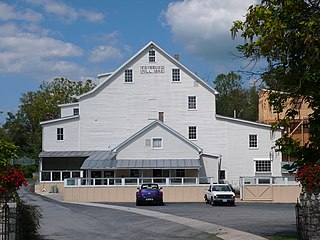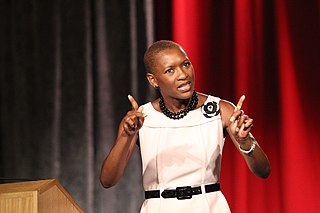Related Research Articles

Shenandoah County is a county located in the Commonwealth of Virginia. As of the 2020 United States Census, the population was 44,186. Its county seat is Woodstock. It is part of the Shenandoah Valley region of Virginia.

Edinburg is a town in Shenandoah County, Virginia, United States. The population was 1,041 at the 2010 census.

Deaf culture is the set of social beliefs, behaviors, art, literary traditions, history, values, and shared institutions of communities that are influenced by deafness and which use sign languages as the main means of communication. When used as a cultural label especially within the culture, the word deaf is often written with a capital D and referred to as "big D Deaf" in speech and sign. When used as a label for the audiological condition, it is written with a lower case d. Carl G. Croneberg coined the term "Deaf Culture" and he was the first to discuss analogies between Deaf and hearing cultures in his appendices C/D of the 1965 Dictionary of American Sign Language.
The history of deaf people and deaf culture make up deaf history. The Deaf culture is a culture that is centered on sign language and relationships among one another. Unlike other cultures the Deaf culture is not associated with any native land as it is a global culture. By some, deafness may be viewed as a disability, but the Deaf world sees itself as a language minority. Throughout the years many accomplishments have been achieved by deaf people. To name the most famous, Ludwig van Beethoven and Thomas Alva Edison were both deaf and contributed great works to culture.

Beverly School for the Deaf is a school, established in 1876, for students from birth to age twenty-two who are Deaf, Hard-of-Hearing and/or have cochlear implants by providing language that is visually accessible via American Sign Language, written English, speech, and AAC/Assistive Technology. The school also serves students who have language issues caused by conditions such as autism spectrum disorder, pervasive developmental disorders, and cerebral palsy.

Jane Fernandes is a Deaf American educator and social justice advocate. As of August 2021, Fernandes is the President of Antioch College in Yellow Springs, Ohio. She previously served as president of Guilford College from 2014 to 2021.

George William Veditz was an American educator, filmmaker, and activist who served as the seventh President of the National Association of the Deaf from 1904 to 1910. He is remembered as one of the most ardent and visible advocates of American Sign Language (ASL) and was one of the first people to film ASL. His 1913 film "Preservation of the Sign Language" was added to the National Film Registry in 2010.
Ella Mae Lentz is a Deaf American author, poet, teacher, and advocate.
The history of deaf education in the United States began in the early 1800s when the Cobbs School of Virginia, an oral school, was established by William Bolling and John Braidwood, and the Connecticut Asylum for the Deaf and Dumb, a manual school, was established by Thomas Hopkins Gallaudet and Laurent Clerc. When the Cobbs School closed in 1816, the manual method, which used American Sign Language, became commonplace in deaf schools for most of the remainder of the century. In the late 1800s, schools began to use the oral method, which only allowed the use of speech, as opposed to the manual method previously in place. Students caught using sign language in oral programs were often punished. The oral method was used for many years until sign language instruction gradually began to come back into deaf education.

Teresa Blankmeyer Burke is a Professor of Philosophy at Gallaudet University. She is the first signing deaf woman to receive a PhD in philosophy in the world, as well as the first deaf person to receive a PhD in philosophy at the University of New Mexico.

Claudia L. Gordon is the first deaf Black female attorney in the United States and the first deaf graduate of American University's law school. She currently works as a Senior Accessibility Strategy Partner at T-Mobile within its Diversity, Equity and Inclusion team. Prior to joining the telecom industry, Gordon held various roles in the public sector from 2002 to 2017—most notably as the associate director in the White House Office of Public Engagement, where she advised White House offices and senior officials including former President Barack Obama on disability issues. This political appointment made Gordon the first deaf person to work at the White House in a detailee capacity.
Beth S. Benedict is a professor in the Department of Communication Studies at Gallaudet University, advocate for the deaf, and a mentor for families with deaf children. Her research focuses on early intervention, early language acquisition, and family involvement. Benedict is also an advocate for the use of bilingualism in education of the deaf - incorporating the value of American Sign Language in deaf children. Benedict advocates for deaf-hearing partnerships, avoiding audism, the importance of bilingual education, deaf culture and the use of sign language while also working as a family mentor for families with deaf children. Recently, she was a keynote speaker for an International Deaf Studies conference and the featured speaker for the deaf education summit. Benedict takes what she researches about deafness and education and shares it broadly by way of talks and application - for example, she has helped the Georgia School for the Deaf work on developing bilingual education in their programs. In 2015 Benedict was the featured speaker at the Deaf education summit in Louisiana - a conference that brought together practitioners, educators, and parents to discuss local issues surrounding education of deaf children.

Opeoluwa Sotonwa is a Deaf Nigerian American attorney, disability rights advocate and literary writer. In February 2021, Governor Charles Baker appointed Sotonwa as the Commissioner and agency head for the Massachusetts Commission for the Deaf and Hard of Hearing. Prior to his appointment as Commissioner, he was the executive director of Missouri Commission for the Deaf and Hard of Hearing. and served previously as Vice President of the National Black Deaf Advocates, the official advocacy organization for thousands of Black Deaf and Hard of Hearing Americans between 2013 and 2015. He is listed among the most influential Deaf People in the United States Opeoluwa Sotonwa attended University of Ilorin Nigeria, where he read law and graduated with LLB degree in 2005. He later proceeded to Nigerian Law School for advanced legal training. He was called to the Nigerian Bar as a Barrister and Solicitor of the Supreme Court of Nigeria in 2007. Opeoluwa worked as staff attorney with Nigerian Legal Aid Council. He later moved to United States to further his legal career and attended Howard University School of Law, where he graduated cum laude with a Master of Laws degree in 2009. Sotonwa earned his doctorate in Law and Policy from Northeastern University's College of Professional Studies in 2018.

Edith Mansford Fitzgerald (1877–1940) was a deaf American woman who invented a system for the deaf to learn proper placement of words in the construction of sentences. Her method, which was known as the 'Fitzgerald Key,' was used to teach those with hearing disabilities in three-quarters of the schools in the United States.
Kendall Demonstration Elementary School (KDES) is a private day school serving deaf and hard of hearing students from birth through grade 8 on the campus of Gallaudet University in the Trinidad neighborhood of Washington, D.C. Alongside Model Secondary School for the Deaf, it is a federally funded, tuition-free demonstration school administered by the Laurent Clerc National Deaf Education Center at Gallaudet University.
Agatha Tiegel Hanson was the second woman to graduate from the National Deaf-Mute College in 1893 and the first woman to receive a Bachelor of Arts from the school. She worked as an educator for deaf students and advocated for the deaf community throughout her life. Hanson also wrote poetry and edited a newspaper for the deaf.
Gertrude Scott Galloway was an American educator and administrator working with deaf children. She was the first female president of the National Association of the Deaf. She is among the first deaf women to head a school for the deaf in the United States. Galloway was an advocate for deaf women throughout her life.

Nellie Jane Norman was a deaf performer, director, professor, and curator, recognized for her work on the faculty of Gallaudet University. She actively promoted deaf culture, language, and art through her contributions to teaching, TV programs, and film festivals. In 2007, she founded the National Deaf Life Museum at Gallaudet.
The deaf/Deaf and hard-of-hearing (DHH) population are underrepresented in science, technology, engineering, and math fields (STEM), despite a history of excellence in these fields. The lack of standard American Sign Language (ASL) vocabulary, engaging hands-on learning environments, and DHH mentors seems to contribute largely to the discrepancy.
References
- 1 2 3 4 5 "National Disability Mentoring Coalition (NDMC)". ndmc.pyd.org. Retrieved 2020-12-16.
- ↑ Sep 11, Kathleen Brockway; comments, 2018 Bio-Fellow – Past Fellows 0 (2018-09-11). "Kathleen L. Brockway, Nonprofit Management Fellow". Respect Ability. Retrieved 2020-12-17.
{{cite web}}: CS1 maint: numeric names: authors list (link) - ↑ Young, Thomsen (2019-03-18). "Exclusive Interview with Kathleen L. Brockway". silent grapevine. Retrieved 2020-12-16.
- ↑ "Trailblazers in the Deaf Community: Famous Authors". The Public Library of Youngstown and Mahoning County. September 24, 2020.
- ↑ Kast, Sheilah; Kempel, Jamyla (July 11, 2014). "Baltimore's Deaf Heritage". WYPR .
- ↑ "5 Deaf Educators Share Inclusivity Tips to Embrace in Your Classroom". National Geographic . September 21, 2020.
- ↑ "Kat Brockway, '93, writes second book for "Images of America" series". gallaudet.edu. Retrieved 2020-12-16.
- 1 2 "A sign of a community: Rarely documented deaf village in Edinburg detailed in book". April 12, 2022.
- ↑ "Traveling statewide exhibit tells of deaf village near Edinburg". nvdaily.com. September 12, 2022.